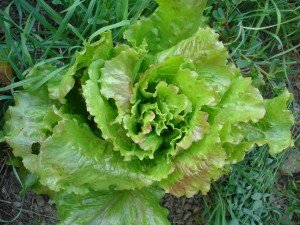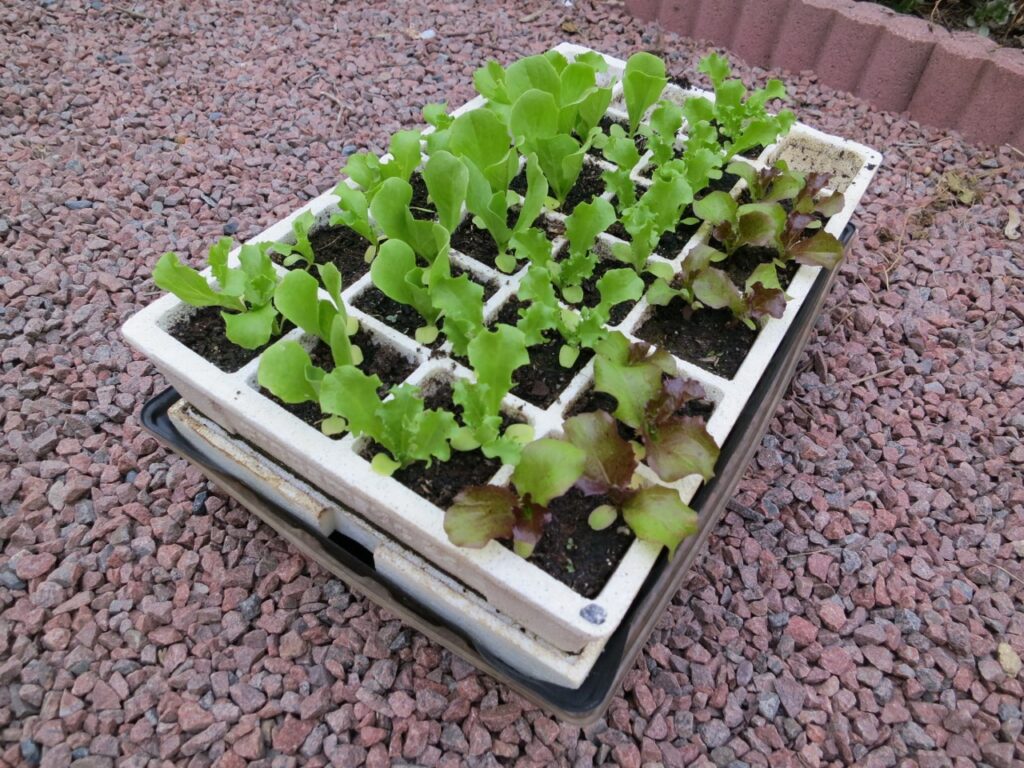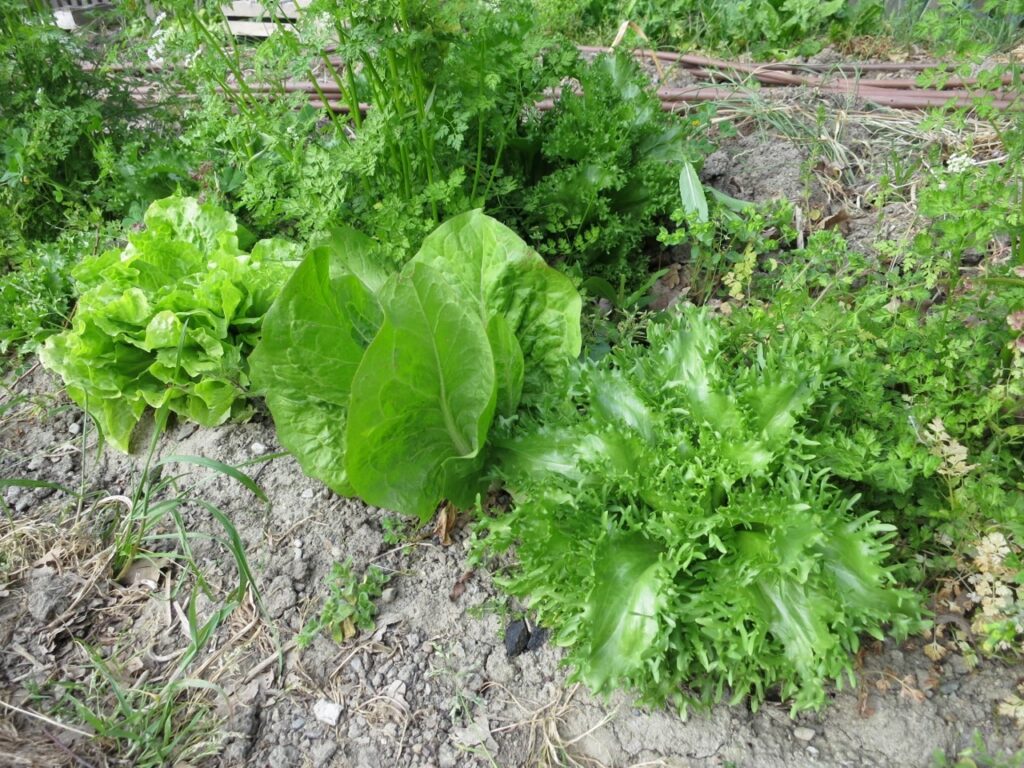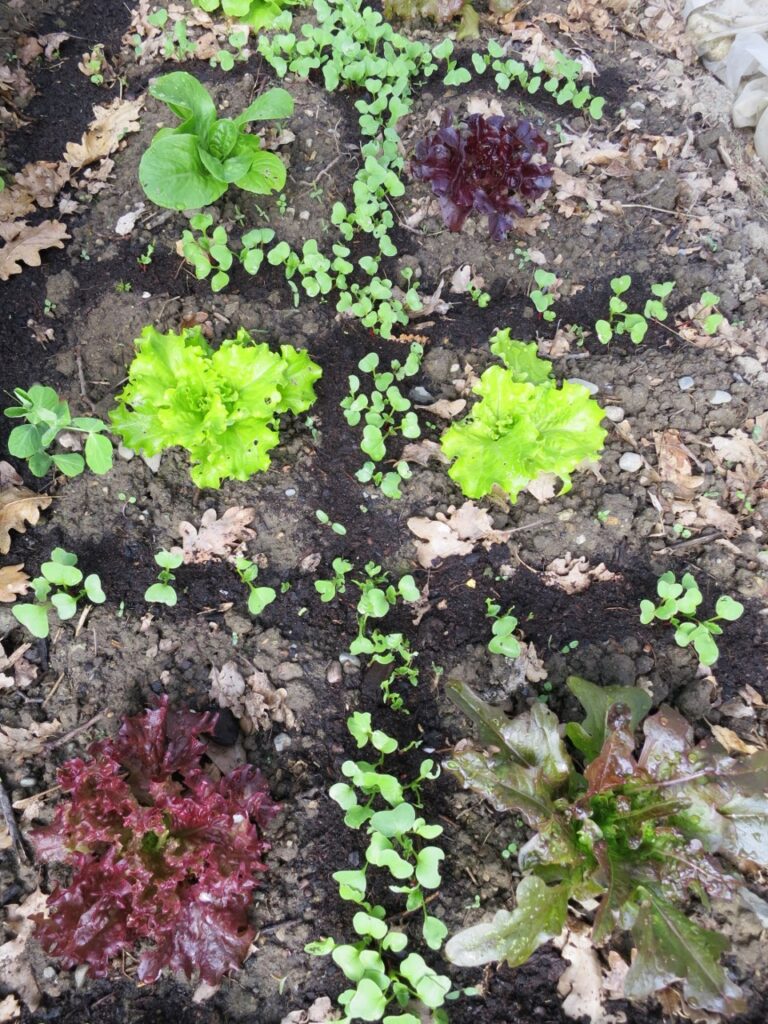Nowadays, lettuce is available in the supermarket all year round. But couldn’t we do the same in our garden?
Most gardeners only grow lettuce at one time of the year: spring, and that’s a shame because they miss out on all kinds of salads that can be grown in other seasons.
In this article, you’ll discover how to enjoy crisp salads grown in your garden almost every day of the year.
We’ll take a look at the different varieties, see which ones are suitable for each season, what pitfalls to avoid so that they grow well and I’ll also give you a growing schedule.
A wide range of salad varieties
Apart from lettuce and batavia which are the most well known, there are many other varieties of lettuce such as leafy chicory, escarole, curly leaf and lamb’s lettuce. These varieties are all resistant to the cold.
Let’s not forget these other kinds of “greens” that can advantageously complement salads: arugula, watercress, purslane, young spinach leaves, pear, beet, and even mustard (yes, I tested by cutting some leaves of the mustard that I had sown to make green manure and it brings a small pungent taste which is not unpleasant).
Asian young shoots like mizuna, pakchoï or tatsoï will bring different shapes of leaves, various textures, soft or crunchy, sweet, bitter or pungent tastes, colors going from dark red to light green almost yellow.
All these plants can be used to create a mesclun to your taste. A mesclun is simply a plate that contains a mixture of at least 5 types of salad.

Knowing the varieties of lettuce adapted to each season
First of all, it is important to know that lettuce is a plant that prefers cooler temperatures to grow, as it is the case in autumn and especially in spring. On the other hand, in summer and winter, it will be necessary to play on adapted varieties to obtain good results.
For me, salad season begins in the fall, with the planting of what are called “winter lettuces”. These lettuces are not well known to the public because the information is well guarded and rarely appears in gardening books. These are lettuces whose young plants are resistant to frost during the winter. At the end of winter and the beginning of spring, they will develop and form a beautiful head that you can start harvesting in March and until the end of April. Here are some varieties: ‘Merveille d’hiver’, ‘d’hiver de Verrières’, ‘Rougette de Montpellier’.
Which salads to plant in spring? I reserve spring for the production of lettuces because in my region of Toulouse, they go to seed very quickly from the first heat of May.
In March, I transplant a few lettuce plants bought in a garden center. These are the only plants I buy during the year, because in March, the days are still short and plants that I would have sown indoors would not receive enough light to develop well.
In April, we can start sowing lettuces that will be harvested in June/July. There are many varieties, my favorites are two old varieties that are easy to grow: ‘Reine de Mai’ and ‘Rouge Grenobloise’.

In spring, all the other “little greens” mentioned above can be sown to make mesclun or to bring an Asian touch to your dishes.
Let’s not forget to mention the lettuces known as “to be cut”, the best known of which is the ‘Oak leaf’. Their big advantage: they can be harvested after a month and a half and the harvest is spread out over time. They are not my favorite because I find that they lack crunchiness in the mouth.
At the end of spring, I prefer to ensure the blow by sowing varieties resistant to the heat of the summer. You can harvest them from July until September. In my garden, the varieties that have proved their worth are the batavia ‘Canasta’, the ‘Cressonnette Marocaine’ (which resists any heat wave) and the so-called ‘fat’ lettuces such as ‘Sucrine’ or ‘Craquerelle du midi’.
From August 15 (and even before in regions with cool summers) until the end of September, it is a good time to sow lamb’s lettuce and chicory. They have tougher leaves than lettuces, which will allow them to resist winter frosts. Often very colorful with red and green mottling or red leaves with white veins, they are very decorative on the plate.

Depending on the region where your garden is located, you will probably have to cover the lettuce plot with a winter cover or a plastic tunnel. This is what allows you to eat lettuce all winter long. To prolong the harvest, pick them leaf by leaf, starting with the outer leaves while the core continues to develop. During the winter, you will have small harvests that will grow with the arrival of spring.
That’s it, we’ve come full circle! We have seen that by choosing the right varieties, you can eat lettuce from the garden all year round.
A few tips on how to grow salads successfully
For a long time I stopped sowing my lettuces in the garden. The emergence is too risky and the slugs throw themselves on the smallest seedling as soon as it emerges. Since I refuse to use chemicals in my garden, I had to adapt.
The solution is to plant all the lettuce seedlings in pots or trays and to transplant them into the ground only when the plants have reached a certain size. This way they will be less attractive to snails and slugs (you will still have to be careful).
To avoid overproduction, I sow few at a time but often: every two weeks. This allows me to spread out the harvest.
You have to know three things about the germination of salad seeds:
They must germinate quickly (in 3 or 4 days) otherwise the risk of going to flower is greatly increased.
The ideal temperature for germination is 18 to 22 degrees. This is why I germinate all my lettuce seedlings inside the house. For summer seedlings, I find a cool room.
They need light to germinate, so don’t put them in the dark.
Once transplanted to the vegetable garden, I have found a few tricks to make the lettuces grow even better. Here are a few of them:
To save space, I plant my lettuces in staggered rows instead of in rows. This way, I can grow 20% more lettuce in the same area!
For the same purpose, I plant radishes between the salads. The radishes will be picked well before the lettuces have grown and, as an added benefit, the lettuces have the property of scaring off flea beetles, those little black fleas that make holes in the leaves of the radishes.

During cultivation, I water my salads with diluted nettle manure every two weeks, which gives them nitrogen which is good for their foliage.
When I harvest a salad, I cut the core off at ground level and leave the roots in the ground. This is good for keeping the soil alive (by decomposing, the root will bring organic matter and enrich the soil) but also, I will get a second harvest! Indeed, before dying completely, the lettuce will grow small leaves that will be delicious to eat.

If you don’t have a vegetable garden but just a balcony, or if you want to grow some salads on a sheltered terrace, it’s very easy to grow them in a large pot. As you can see on the picture, I even made an improvised “greenhouse” with 5 liter plastic bottles.
I’ve put together some more tips on salads, you can find them by following this link.
My growing calendar to harvest salads all year round
Here is a table that will allow you at a glance to know which salads to grow at each time of the year. Depending on the climate of your region, and with the experience you will have acquired by experimenting a little the first years, you will adapt these dates to your vegetable garden.
- January Salads are in vegetative rest. Very few harvests are possible.
- February The days are getting longer. The leafy chicory and winter lettuce are slowly starting to grow again, and chicory harvests are possible again, as well as lamb’s lettuce.
- March If you have a greenhouse, you can start the first lettuce seedlings. If not, buy lettuce plants at the garden center, the chicory harvest continues and the winter lettuce starts to peel.
- April Spring is here and gives you abundant chicory and winter lettuce crops.Transplant your March seedlings if you have done so.Every two weeks, sow or buy a few spring lettuce/chop lettuce plants or batavias to stagger the harvest.
- Also sow any “small greens” such as mesclun or Asian leaves.
- May Start harvesting the lettuces you sowed or transplanted in early spring, and regularly sow a small batch of lettuces that will withstand the summer heat.
- June You will finish picking the spring salads and continue to sow or transplant salads for the summer.
- July You will enjoy the first harvest of summer salads, like crispy batavias. In regions with short summers, you can start sowing lamb’s lettuce and leafy chicory for the winter.
- In cooler regions, transplant the lettuces you planted in JulySow a final batch of lettuce for the fall.
- In warm regions, wait until August 15 to plant lamb’s lettuce and leafy chicory for winter.
- September You will finish harvesting summer salads.Lettuces are growing faster than in the spring and you will start enjoying them at the end of the month.Replant what you planted in August.
- Continue planting lamb’s lettuce.
Towards the end of the month, plant your winter lettuce, all at once.
- October Feast on the last batch of lettuce and start harvesting the lamb’s lettuce.
- November You can pick the outer leaves of chicory. The core will continue to grow.Continue staggered harvests of lamb’s lettuce.
- December The lettuces enter a vegetative rest and will stop growing, eventually a few small leaf harvests are possible.

